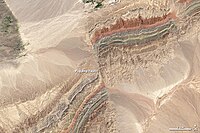
Photo from wikipedia
The clay mineralogy of fault gouges has important implications for the frictional properties of faults, often identified as a major factor contributing to profound fault weakness. This work compares the… Click to show full abstract
The clay mineralogy of fault gouges has important implications for the frictional properties of faults, often identified as a major factor contributing to profound fault weakness. This work compares the frictional strength of a group of Mg‐rich minerals common in the Mg‐Al‐Si‐O compositional space (talc, saponite, sepiolite, and palygorskite) by conducting triaxial frictional tests with water or argon as pore fluid. The studied minerals are chemically similar but differ in their crystallographic structure. Results show that fibrous Mg‐rich phyllosilicates are stronger than their planar equivalents. Frictional strength in this group of minerals is highly influenced by strength of the atomic bonds, continuity of water layers within the crystals, and interactions of mineral surfaces with water molecules, all of which are dictated by crystal structure. The formation and stability of the minerals studied are mainly controlled by small changes in pore fluid chemistry, which can lead to significant differences in fault strength.
Journal Title: Geophysical Research Letters
Year Published: 2017
Link to full text (if available)
Share on Social Media: Sign Up to like & get
recommendations!